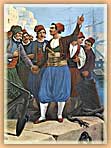 |

The besieged Ottomans in forts of the Morea
could be supplied with troops and provisions by land or sea. The second possibility demanded the mobility of the numerous ships from Hydra, Spetses and Psara. The fleet of these three islands numbered several hundreds of lightly armed small merchant ships which were also effective in piracy. Although these ships did not constitute a proper wartime fleet, their crews' experience and the flexibility of their ships in the Aegean could obstruct the action of the Ottoman fleet. Inhabited almost exclusively by Greeks, apart from Rhodes, Kos and Chios, where Muslims lived as well, the Aegean Islands gradually declared for the Revolution from the first ten days of April onwards.
The Cycladic Islands such as Syros, Tinos and Naxos, where the majority of the inhabitants were Catholics, are an exception. Spetses, Psara, Samos and especially Hydra were the centre of the revolutionary struggle in the Aegean although the local elites appeared hesitant at first
as were those of the Peloponnese. In fact, in Hydra, a powerful naval centre dominated by the Kountouriotis family, the war was declared thanks to the persistence of a regional factor of minor influence.
This was Antonis Oikonomou, member of the Philiki Etaireia, who led the uprising in the beginning but was soon eliminated. In Samos, Lykourgos Logothetis, a former regional leader and member of the Philiki Etaireia, who imposed his power over the other local agents, prevailed.
In the first months of the Revolution Greek ships enjoyed relative freedom of movement in the Aegean. Part of the Ottoman fleet remained in Constantinople harbour as there was the fear of a new Russo-Ottoman war, while another part was on the coast of Epirus engaged in the war against Ali Pasha. Thus, the Greek fleet, practically unobstructed, assaulted isolated Ottoman ships, many of which were captured. In addition the Greek fleet participated in the sieges of the forts of Nauplion (with the renowned Laskarina Bouboulina as a leader), Monemvasia, Naupaktos and others. Furthermore, piratical raids were carried out to the detriment of neutral merchant ships as well as raids on the coast of Asia Minor. In reality, there was no organized Greek fleet to follow a cohesive plan but the ships' crews cooperated on individual operations, not always effectively. Thus, when part of the Ottoman fleet tried to sail out of the
Dardanelles in order to supply the besieged forts of the Peloponnese and transport troops it was proved that the Greek ships could not engage the Ottoman ships.
There were some successful isolated operations, based on both heroism and on a naval war tactic. This was
the fireship, a specially formed ship loaded with inflammable and explosive materials which was attached to the Ottoman ships, fired and
sunk with them. Ottoman fear of the fire-raisers restricted the movement of their fleet. In this first period is seems that both sides tried to prevent conflict, an evolution which certainly favoured the development of the Revolution on both the mainland and the islands.
|


 |